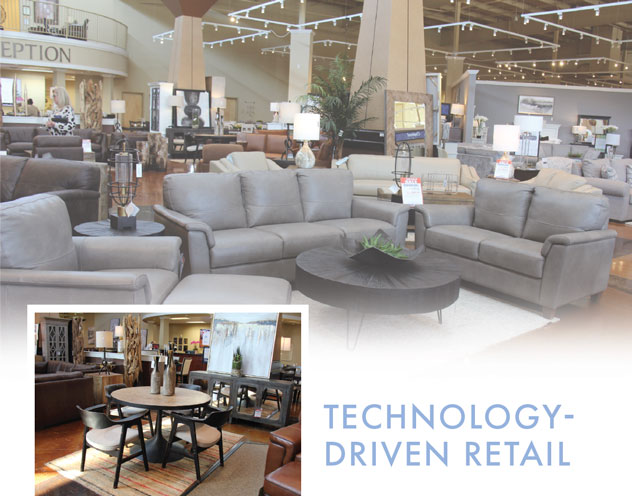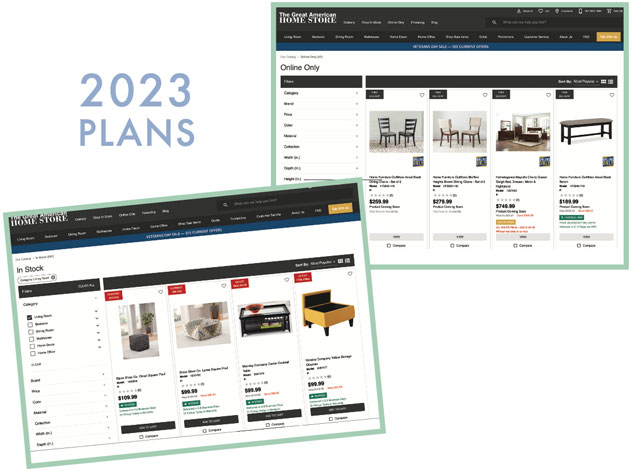Retail Success: Great American Home Store |

Great American Home Store Addresses Tech Challenges
The marketing
team at fast- growing,
technology- driven GAHS shares their thoughts about data collection,
software integration,
analysis and more.
A lot has happened since Furniture World last spoke with Ron Becker, one of the founders and general manager of The Great American Home Store; Jack Wells Jr., marketing director; and Justin Bowen, digital manager.
This fast-growing, technology-driven retailer operates stores in Mississippi and Western Tennessee. They tout the largest selection of in-stock home furnishings in the Midsouth area, with the ability to send customers home with their purchase on the same day.
Wells and Bowen agreed to provide Furniture World readers with insight into their recent advances in retail technology integration, advertising, metadata collection/entry innovation, eCommerce and staffing.
Product Data Entry Innovation
It’s evident when browsing the www.greatamericanhomestore.com website that GAHS puts a lot of effort into collecting and entering product data to help shoppers find items by product attributes such as price, color, dimensions, style, materials and more.
In recent years, the lack of product information and decent photography has become a pet peeve for many furniture retailers, and GAHS has developed a unique approach.
“Last year, we expanded our chat department by rolling product content development into the chat role,” explained Justin Bowen. “Instead of one person entering data into the website database, the team shares this responsibility. They develop relationships with our manufacturers and talk with reps to help build the database. An added benefit of this arrangement is that the team gains product knowledge expertise that can be directly passed on to shoppers.
“Last year, we expanded
our chat department by
rolling product content development into the chat role. Instead of one person
entering data into the
website database, the team shares this responsibility.”
“The chat team enters metadata such as color and style, uploads photos and writes descriptions while working in tandem with our video producers. Jack Wells writes the scripts and has a team that shoots, edits and posts. At Great American Home Store, much effort goes into producing product content. It’s an initiative we started a couple of years ago, then really ramped up. We also work with Live Furnish to create 3D-rendered images for products that don’t have decent photography. The 3D has increased views and both online and in-store sales on those products, even in times when overall sales were flat.”
Photography: An
Industry Problem
Marketing Director Jack Wells shared his views about the present state of manufacturer-supplied product photography. “In the old days,” he said, “manufacturers were good about getting us beautiful photos. Now, they seem not to care. And that’s especially true for imported lines. It has come to the point now that we might be able to get a room shot of a bedroom from some manufacturers, for instance, and probably not a very good one. However, they don’t shoot individual pieces. That’s why we set up a white wall in our warehouse to photograph everything that comes in. And then, of course, we shoot the video on the floor. If we pull a still from these videos, they generally look better than manufacturer-supplied materials. Our experience is that too many manufacturers just don’t see the value in providing quality images for retailers. It’s odd because having access to excellent photography, especially for our website, is more important than ever. It helps turn merchandise. It’s surprising that there isn’t more interest in addressing this issue, given the benefits to manufacturers.”
eCommerce Initiatives
In 2021, Ron Becker asked Justin Bowen to initiate an eComm program for non-stocking products. “His idea,” said Bowen, “was to expand both our product selection and trading area. Right now, we are at the finish line for that project. It is going to at least double the number of online SKUs, allowing us to offer a wider catalog including better-quality items.”
When Furniture World asked how GAHS might present a wide selection of products in a way that is still easy to shop, Bowen replied, “When shoppers go to big eCommerce sites, there can be 10,000 items to look through, which is daunting. That’s why furniture retailers must either be very good at merchandising their websites or make certain their product filters are easy to use. Frankly, though, I think we all have a way to go to make the experience of navigating websites quicker and easier.
“In the old days,
manufacturers were
good about getting us beautiful photos. Now, they seem not to care.
And that’s especially true for imported lines.”
“Great American Home Store is, therefore, taking a ‘less is more,’ curated approach to assure that our eCommerce products are up to our standards and that they make sense for our customers.”
“To advance this effort,” Jack Wells added, “we’ve partnered with vendors who will direct ship to customers anywhere in the country. We will also work with Freight Club to set up LTL deliveries.
“Online, we include a special tag that lets shoppers know that these are online-only products priced to include free shipping, which is doorstep. Returns will be handled through Rush Market (www.rushmarket.com) for resale through their brick-and-mortar outlets.”

Advertising Post-Pandemic
“During the pandemic,” recalled Wells, “Great American Home Store cut back on advertising but kept our name out there.
“Some of our largest competitors didn’t do the same, which was unfortunate because we are heavily cross- shopped. When we all advertise, it builds overall traffic and sales.”
“Like many other retailers who experienced backlog issues during the pandemic,” Bowen recalled, “our store’s general manager, Ron Becker, decided to decrease advertising by 25{a57a8b399caa4911091be19c47013a92763fdea5dcb0fe03ef6810df8f2f239d} to avoid raising customer expectations.
“Business was booming, but In December 2021, we started to see sales soften, so we went full on again with advertising, adding digital channels, Connected TV (CTV) and more social.”

Pictured in the tech stack graphic are (l-r) Justin Bowen, digital manager at Great American Home Store; Ron Becker, one of the founders and general manager; and Jack Wells Jr., marketing director.
Sorting Through
Shopping Pattern Data
“In late 2019, we also took a closer look at our customer demographics, merchandising and buying preferences,” said Bowen. “Starting in 2016, we noticed a trend toward our shoppers and buyers skewing older. It was troubling because the number of shoppers in the 75+ demographic is small in comparison to younger demographics that continued to represent a large majority of our shoppers.
“This change correlated with an adjustment in our merchandise toward more refined looks and upper-end goods.
“We were just getting ready to refocus on bringing back younger customers when the pandemic hit. That initiative was put on pause for a while so we could direct our full attention to pandemic-related issues.”
Recently, Ron Becker and the GAHS marketing team circled back to adjust their merchandising to appeal more to this younger group.
They developed a style survey, “the primary goal of which,” recalled Bowen, “was to collect data to help us adjust merchandising to attract shoppers we had lost.
“The style survey also asks them about their age range, color preference, product category and budget. It provides a tremendous amount of insight for our buyers regarding what to purchase at Market for each age cohort.”
Hiring & Retention
“That initial survey was all text-based. When we showed the first survey results to our merchandising team, they justifiably questioned the results. It wasn’t clear what respondents meant when they specified a preference, for example, for modern, traditional or contemporary style. It became clear that we needed to create a picture-based survey. The revised survey includes over 90 images of varied styles to choose from. The photos aren’t labeled with text, so shoppers choose based on the visuals. When the survey is competed, their personal ‘style’ is revealed.
“The style survey also asks them about their age range, color and product category preferences and budget. We’ve gotten tremendous response—about 100 per day. The survey has provided our buyers with insight regarding what to purchase at Market for each age cohort.
“Buyers often go to Market without tangible information on what, for example, 35 to 44 or 25 to 34-year-old shoppers are looking for.”
Technology Integration
Bowen explained that until recently, GAHS had a number of stand-alone technology platforms that weren’t fully integrated or efficient.
“I can go online and pull up any furniture retailer’s tech stack. From what I’ve seen, lots of furniture retailers aren’t set up in a way that provides them with adequate data.”
“That’s why one of my primary goals has been to get our systems working together,” he said. “We succeeded in getting our POS system to communicate well with our current website to transfer inventory data in real-time. However, it has been an enormous challenge to get them talking with our other systems.
“Fortunately, last year we started working with Zapier (zapier.com), a company that produces middleware software. Essentially, it acts as a hub for developers to connect their platforms, creating a lingua franca, so to speak, used by thousands of companies. It’s already helping us to integrate other systems produced by developers who plan to support our integration initiative next year.”
Hiring the Right People
Jack Wells commented that Justin Bowen’s role at Great American Home Store has changed at least a dozen times since he’s been on Jack’s team. “Whenever we moved him around, it has been tough finding people to replace him in those positions,” he explained. “Recruiting is a challenge for every retailer and for every job description.”
“Hiring people who can do critical analysis is a must for retailers,” Bowen added. “To be agile, someone on staff needs to be able to track and understand the numbers in each department. Without that capability, it’s difficult to make good decisions. I can go online and pull up any furniture retailer’s tech stack. From what I’ve seen, lots of furniture retailers aren’t set up in a way that provides them with adequate data. That’s critically important, but they also need the right people to interpret it. And not just one person. Otherwise, it’s challenging to get a rounded perspective.
“Here at Great American Home Store, we are wary of delegating this responsibility to third parties.”
Wells agreed. “We don’t feel we can count on vendors to provide primary analysis. Every technology supplier has a dashboard, but Justin has found, when he delves into the details, that some are not that transparent. Having said that, we do have some partners that provide valuable outside perspective and consultation.
“Lots of retailers buy technology they don’t understand. Every day there’s a new shiny penny. So how can retailers like us find people like Justin? Well, we look for employees who have a certain mindset and talents.”
Bowen recalled that when he first applied for a job at GAHS, his tech experience was limited to having a Facebook account.
“They took me on, starting part-time managing the website and posting to
“Zapier produces
middleware software that acts as a hub for developers to connect their platforms,
creating a lingua franca,
so to speak, used by
thousands of companies.”
“They took me on, starting part-time managing the website and posting to social media. It was just Jack and me for a while. One thing led to another, and we now have a team of eight in the marketing department. We hire people who love to learn. Technology is changing so fast that the tools we use today are not the same ones we used three months ago. Ideally, we want to hire people who can take on almost any task and jump at the chance to learn how to do it.”
Wells added that Great American Home Store allots hours every week to employees for training purposes. Some of this work is assigned and at other times employees choose which skill, that will benefit the company, they want to focus on. “That’s true on the technology side and for our video production team as well,” he said.
Adapting Advertising
“We are big TV advertisers and recently hired a new agency, MNTN, whose chief creative officer is the actor Ryan Reynolds, to help us develop new programs,” said Wells.
“Podcast advertising was added to the mix in October. We’ve been advertising on streaming audio and podcast apps such as Pandora, iHeartRadio, Spotify and others. For radio, a rifle approach on weekends when people are out shopping has worked well for us. Connected TV (CTV) has also become a big thing for us now.”
CTV supports streaming of video through devices and apps such as Roku, Amazon Fire TV and Apple TV, to name just a few of the many ways to view streaming content. Over the top (OTT) content is delivered via the internet to any device including mobile phone, PC, or tablet . Some providers for OTT content are Hulu, Netflix, Prime and other similar services that don’t necessarily require a satellite or cable subscription. OTT content can be streamed over CTV to a television, for example, equipped with a streaming device or built-in smart apps within the TV.
Bowen elaborated. “OTT is an umbrella term for a lot of different advertising mediums and CTV is a subset of that. A portion of CTV goes to non-TV devices, but the majority is big screen. Since we started working with MNTN, we have been using their blended approach which has been quite successful. My prior experiences with blended OTT/CTV were not as positive.”

“We hire people who love to learn. Technology
is changing so fast that the tools we use today are not the same ones we used three months ago.”
Furniture World asked Bowen if GAHS’ GM, Ron Becker, has concerns about using more invasive forms of advertising.
“Ron is one of the most ethical people in our industry. He wants to make sure that we are doing things above board and not doing anything that could be seen as creepy.
“We don’t share customer data outside of our company and take care to be respectful communicating without inundating customers and prospects with messages. Nor do we take people’s contact information if they haven’t given it to us and are strongly opposed to buying lists of any kind.
“It’s a consent-based approach, with at most a few emails and one text a week. Great American Home Store makes it easy for people to opt out and steers clear of super-invasive marketing tactics. We’ve done competitor targeting for several years, which always gets a good return. Our AB tests show its effectiveness at anywhere from 40 to 200 percent lifts depending on the month.
“We aren’t, however, a big fan of identity resolution, which is an expensive way to peek in on people and isn’t that useful in our estimation. It’s more useful for anonymizing site visitors but doesn’t present a meaningful way to re-target them unless a retailer is doing sophisticated marketing.”
Conclusion
In closing, Furniture World asked Jack Wells what he thinks retailers need to do in 2023. “We’re going to have to remain agile,” he advised. “Be ready to change quickly because none of us really know what’s going to come up. It could be another COVID spike or unknown shocks once we get through the current election cycle. Fuel prices, inflation and international conflicts are all unknowns. If the last couple of years has taught retailers anything, it’s that we all need to make contingency plans.
“I’m very proud of the people at Great American Home Store,” Wells added. “We are not an enterprise retailer with unlimited funds. Neither have we moved in a significant way into the AI world, although it’s on the horizon. But, since I came on board in 2011, we’ve grown our small company from about $20 million to $50 million in sales because of the people here in this office.”

Online, GAHS includes a special tag that lets shoppers know which products are online-only offerings that include free doorstep shipping. Other tags alert shoppers to items that are outlet, closeout or on sale.
